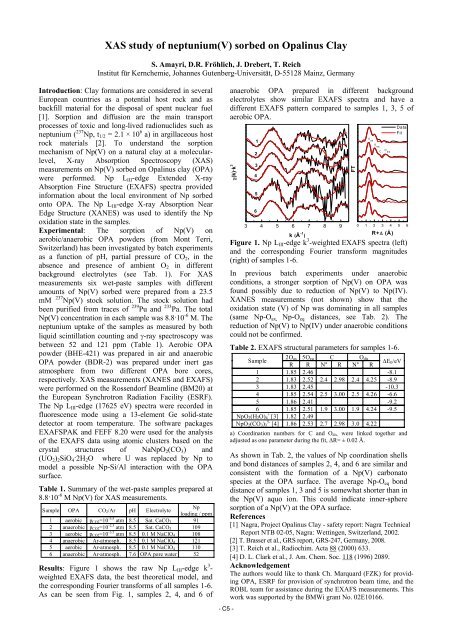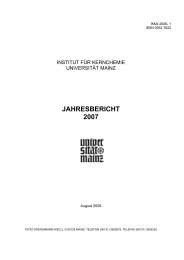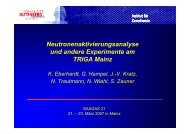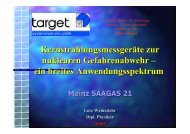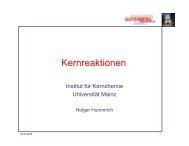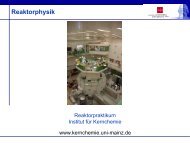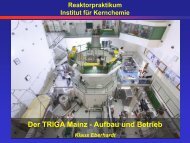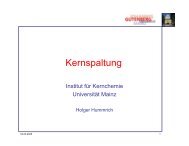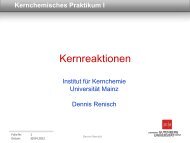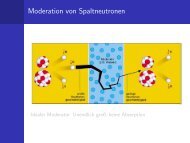institut für kernchemie universität mainz jahresbericht 2009
institut für kernchemie universität mainz jahresbericht 2009
institut für kernchemie universität mainz jahresbericht 2009
Create successful ePaper yourself
Turn your PDF publications into a flip-book with our unique Google optimized e-Paper software.
XAS study of neptunium(V) sorbed on Opalinus Clay<br />
S. Amayri, D.R. Fröhlich, J. Drebert, T. Reich<br />
Institut <strong>für</strong> Kernchemie, Johannes Gutenberg-Universität, D-55128 Mainz, Germany<br />
Introduction: Clay formations are considered in several<br />
European countries as a potential host rock and as<br />
backfill material for the disposal of spent nuclear fuel<br />
[1]. Sorption and diffusion are the main transport<br />
processes of toxic and long-lived radionuclides such as<br />
neptunium ( 237 Np, t1/2 = 2.1 × 10 6 a) in argillaceous host<br />
rock materials [2]. To understand the sorption<br />
mechanism of Np(V) on a natural clay at a molecularlevel,<br />
X-ray Absorption Spectroscopy (XAS)<br />
measurements on Np(V) sorbed on Opalinus clay (OPA)<br />
were performed. Np LIII-edge Extended X-ray<br />
Absorption Fine Structure (EXAFS) spectra provided<br />
information about the local environment of Np sorbed<br />
onto OPA. The Np LIII-edge X-ray Absorption Near<br />
Edge Structure (XANES) was used to identify the Np<br />
oxidation state in the samples.<br />
Experimental: The sorption of Np(V) on<br />
aerobic/anaerobic OPA powders (from Mont Terri,<br />
Switzerland) has been investigated by batch experiments<br />
as a function of pH, partial pressure of CO2, in the<br />
absence and presence of ambient O2 in different<br />
background electrolytes (see Tab. 1). For XAS<br />
measurements six wet-paste samples with different<br />
amounts of Np(V) sorbed were prepared from a 23.5<br />
mM 237 Np(V) stock solution. The stock solution had<br />
been purified from traces of 239 Pu and 233 Pa. The total<br />
Np(V) concentration in each sample was 8.8·10 -6 M. The<br />
neptunium uptake of the samples as measured by both<br />
liquid scintillation counting and γ-ray spectroscopy was<br />
between 52 and 121 ppm (Table 1). Aerobic OPA<br />
powder (BHE-421) was prepared in air and anaerobic<br />
OPA powder (BDR-2) was prepared under inert gas<br />
atmosphere from two different OPA bore cores,<br />
respectively. XAS measurements (XANES and EXAFS)<br />
were performed on the Rossendorf Beamline (BM20) at<br />
the European Synchrotron Radiation Facility (ESRF).<br />
The Np LIII-edge (17625 eV) spectra were recorded in<br />
fluorescence mode using a 13-element Ge solid-state<br />
detector at room temperature. The software packages<br />
EXAFSPAK and FEFF 8.20 were used for the analysis<br />
of the EXAFS data using atomic clusters based on the<br />
crystal structures of NaNpO2(CO3) and<br />
(UO2)2SiO4·2H2O where U was replaced by Np to<br />
model a possible Np-Si/Al interaction with the OPA<br />
surface.<br />
Table 1. Summary of the wet-paste samples prepared at<br />
8.8·10 -6 M Np(V) for XAS measurements.<br />
Sample OPA CO2/Ar pH Electrolyte<br />
Np<br />
loading / ppm<br />
1 aerobic pCO2=10 -3.5 2<br />
atm 8.5<br />
anaerobic pCO2=10<br />
Sat. CaCO3 91<br />
-2.3 3<br />
atm 8.5<br />
aerobic pCO2=10<br />
Sat. CaCO3 109<br />
-3.5 atm 8.5 0.1 M NaClO4 108<br />
4 anaerobic Ar-atmosph. 8.5 0.1 M NaClO4 121<br />
5 aerobic Ar-atmosph. 8.5 0.1 M NaClO4 110<br />
6 anaerobic Ar-atmosph. 7.6 OPA pore water 52<br />
Results: Figure 1 shows the raw Np LIII-edge k 3 -<br />
weighted EXAFS data, the best theoretical model, and<br />
the corresponding Fourier transforms of all samples 1-6.<br />
As can be seen from Fig. 1, samples 2, 4, and 6 of<br />
anaerobic OPA prepared in different background<br />
electrolytes show similar EXAFS spectra and have a<br />
different EXAFS pattern compared to samples 1, 3, 5 of<br />
aerobic OPA.<br />
χ(k)·k 3<br />
- C5 -<br />
2<br />
3<br />
4<br />
5<br />
6<br />
1<br />
O<br />
ax<br />
O<br />
eq<br />
O<br />
C dis<br />
Data<br />
Fit<br />
3 4 5 6 7 8 9 0 1 2 3 4 5 6<br />
k (Å -1 )<br />
R+Δ (Å)<br />
Figure 1. Np LIII-edge k 3 -weighted EXAFS spectra (left)<br />
and the corresponding Fourier transform magnitudes<br />
(right) of samples 1-6.<br />
In previous batch experiments under anaerobic<br />
conditions, a stronger sorption of Np(V) on OPA was<br />
found possibly due to reduction of Np(V) to Np(IV).<br />
XANES measurements (not shown) show that the<br />
oxidation state (V) of Np was dominating in all samples<br />
(same Np-Oax, Np-Oeq distances, see Tab. 2). The<br />
reduction of Np(V) to Np(IV) under anaerobic conditions<br />
could not be confirmed.<br />
Table 2. EXAFS structural parameters for samples 1-6.<br />
FT<br />
2Oax 5Oeq C Odis<br />
Sample<br />
R R N a R N a R<br />
ΔE0/eV<br />
1 1.85 2.46 -8.1<br />
2 1.83 2.52 2.4 2.98 2.4 4.25 -8.9<br />
3 1.83 2.45 -10.3<br />
4 1.85 2.54 2.5 3.00 2.5 4.26 -6.6<br />
5 1.86 2.41 -9.2<br />
6 1.85 2.51 1.9 3.00 1.9 4.24 -9.5<br />
NpO2(H2O)4 + [3] 1.82 2.49<br />
NpO2(CO3)3 5- [4] 1.86 2.53 2.7 2.98 3.0 4.22<br />
a) Coordination numbers for C and Odis, were linked together and<br />
adjusted as one parameter during the fit, ΔR= ± 0.02 Å.<br />
As shown in Tab. 2, the values of Np coordination shells<br />
and bond distances of samples 2, 4, and 6 are similar and<br />
consistent with the formation of a Np(V) carbonato<br />
species at the OPA surface. The average Np-Oeq bond<br />
distance of samples 1, 3 and 5 is somewhat shorter than in<br />
the Np(V) aquo ion. This could indicate inner-sphere<br />
sorption of a Np(V) at the OPA surface.<br />
References<br />
[1] Nagra, Project Opalinus Clay - safety report: Nagra Technical<br />
Report NTB 02-05, Nagra: Wettingen, Switzerland, 2002.<br />
[2] T. Brasser et al., GRS report, GRS-247, Germany, 2008.<br />
[3] T. Reich et al., Radiochim. Acta 88 (2000) 633.<br />
[4] D. L. Clark et al., J. Am. Chem. Soc. 118 (1996) 2089.<br />
Acknowledgement<br />
The authors would like to thank Ch. Marquard (FZK) for providing<br />
OPA, ESRF for provision of synchrotron beam time, and the<br />
ROBL team for assistance during the EXAFS measurements. This<br />
work was supported by the BMWi grant No. 02E10166.


